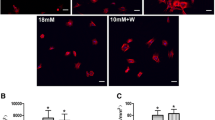Abstract
In recent time, vanadium compounds are being used as antidiabetic drug and in orthopedic implants. However, the exact role of this incorporated vanadium in improving the quality of bone structure and morphology is not known. The impact of vanadium ion was studied and compared to other trace metal ions with respect to the proliferation and osteoblast differentiation of C3H10t1/2 cells. Toxicity profile of these trace metal ions revealed a descending toxicity trend of Fe2+ > Zn2+ > Cu2+ > Co2+ > Mn2+ > V5+ > Cr2+. The effect of vanadium and other trace metal ions on osteoblast differentiation was evaluated by culturing the cells for 10 days in osteoblastic medium supplemented with different trace ions at concentrations lower than their cytotoxic doses. The results indicated that vanadium has maximum impact on the induction of osteoblast differentiation by upregulating alkaline phosphatase activity and mineralization by up to 145 and 150 %, respectively (p < 0.05), over control. Cu2+ and Zn2+ had a mild inhibitory effect, while Mn2+, Fe2+, and Co2+ demonstrated a clear decrease in osteoblast differentiation when compared to the control. The data as presented here demonstrate that orthopedic implants, if supplemented with trace metals like vanadium, may provide a source of better model for bone formation and its turnover.






Similar content being viewed by others
References
Fraga CG (2005) Relevance, essentiality and toxicity of trace elements in human health. Mol Aspects Med 26:235–244
Ming L, Jason JS, Wenjun D, Debbie CC (2009) Anti-diabetic effects of sodium 4-amino-2,6-dipicolinatodioxovanadium (V) dihydrate in streptozotocin-induced diabetic rats. J Inorg Biochem 103:585–589
Thompson KH, Orvig C (2006) Vanadium in diabetes: 100 years from phase 0 to phase I. J Inorg Biochem 100:1925–1935
Thrailkill KM, Lumpkin CK Jr, Bunn RC, Kemp SF, Fowlkes JL (2005) Is insulin an anabolic agent in bone? Dissecting the diabetic bone for clues. Am J Physiol Endocrinol Metab 289:735–745
Navarro M, Michiardi A, Castano O, Planell JA (2008) Biomaterials in orthopaedics. J R Soc Interface 5:1137–1158
Zhi LS, John CW, Hanks CT (1997) Effects of metal ions on osteoblast-like cell metabolism and differentiation. J Biomed Mater Res 34:29–37
Fukui K, Fujisawa Y, Ohya Nishiguchi H, Kamada H, Sakurai H (1999) In vivo coordination structural changes of a potent insulin-mimetic agent, bis(picolinato)oxovanadium(IV), studied by electron spin-echo envelope modulation spectroscopy. J Inorg Biochem 77:215–24
Srivastava AK, Mehdi MZ (2005) Insulino-mimetic and anti-diabetic effects of vanadium compounds. Diabet Med 22(1):2–13
Mosmann T (1983) Rapid colorimetric assay for cellular growth and survival: application to proliferation and cytotoxicity assays. J Immunol Methods 65:55–63
Bessey OA, Lowry OH, Brock MJ (1946) A method for the rapid determination of alkaline phosphatase with five cubic millilitres of serum. J Biol Chem 164:321–329
Meloan SN, Puchtler H (1985) Chemical mechanisms of staining methods: von Kossa's technique. What von Kossa really wrote and a modified reaction for selective demonstration of inorganic phosphate. J Histotechol 8:11–13
Chomczynski P, Sacchi N (1987) Single step method of RNA isolation by acid guanidinium thiocyanate–phenol–chloroform extraction. Anal Biochem 162:156–159
Muñoz-Torres M, Jódar E, Escobar-Jiménez F, López-Ibarra PJ, Luna JD (1996) Bone mineral density measured by dual X-ray absorptiometry in Spanish patients with insulin-dependent diabetes mellitus. Calcif Tissue Int 58(5):316–319
Tsiani E, Fantus IG (1997) Vanadium compound: biological actions and potential as pharmacological agents. Trends Endocrinol Metab 8(2):51–58
Moses HL, Coffey RJ, Leof EB, Lyons RM, Keski-Oja J (1987) Transforming growth factor beta regulation of cell proliferation. J Cell Physiol Suppl 5:1–7
Hsing-Hsien C, Ming-Hoang L, Wen-Chi H, Chen-Ling H (2004) Antioxidant effects of chromium supplementation with type 2 diabetes mellitus and euglycemic subjects. J Agric Food Chem 52(5):1385–1389
Hwang SL, Chang HW (2012) Natural vanadium-containing Jeju ground water stimulates glucose uptake through the activation of AMP-activated protein kinase in L6 myotubes. Mol Cell Biochem 360(1–2):401–9
Cortizo AM, Salice VC, Etcheverry SB (1994) Vanadium compounds: their action on alkaline phosphatase activity. Biol Trace Elem Res 41:331–339
Facchini DM, Yuen VG, Battell ML, McNeill JH, Grynpas MD (2006) The effects of vanadium treatment on bone in diabetic and non-diabetic rats. Bone 38(3):368–77
Nielsen FH, Uthus EC (1990) Vanadium in biological systems: physiology and biochemistry. Kluwer, London
Schwartz AV (2003) Diabetes mellitus: does it affect bone? Calcif Tissue Int 73:515–519
Stankiewicz PJ, Tracey AS, Crans DC (1995) Inhibition of phosphate-metabolizing enzyme by oxovanadium (V) complexes. Met Ions Biol Syst 31:287–324
Hila TK, Judith K, Tal S, Shira GA, Galit S, Hava GH, Yuval YE (2003) Protein tyrosine phosphatase ε inhibits signaling by mitogen-activated protein kinases. Mol Cancer Res 1:541–550
Mahealani K, Monteilh Z, Meredith C, Monica JSN, Andrew MS, Reinhold P, Andrea F (2003) TRPM7 provides an ion channel mechanism for cellular entry of trace metal ions. J Gen Physiol 121:49–60
Ramirez-Diaz MI, Diaz-Perez C, Vargas E, Riveros-Rosas H, Campos-Garcia J, Cervantes C (2008) Mechanisms of bacterial resistance to chromium compounds. Biometals 21:321–332
Cyrille F, Alain P, Fackson M, John A, David JZ, MaryamT OLH (2006) Effect of cobalt and chromium ions on human MG-63 osteoblasts in vitro: morphology, cytotoxicity, and oxidative stress. Biomaterials 27:3351–3360
Preet ABL, Gupta MR, Siddiqui PK, Yadava NZ (2005) Restoration of ultrastructural and biochemical changes in alloxan induced diabetic rat sciatic nerve on treatment with Na3VO4 and Trigonella—a promising antidiabetic agent. Mol Cell Biochem 278:21–31
Acknowledgments
This work was funded by the Department of Biotechnology, Government of India (reference no. DBT-JRF/08-09/459), Ministry of Human Resource and Development (MHR03-412-Fig ‘B’), and Uttarakhand State Council for Science and Technology (reference no. UCS&T/R&D/LS-10/11-12/4224/1) as funded project to PR.
Author information
Authors and Affiliations
Corresponding author
Rights and permissions
About this article
Cite this article
Srivastava, S., Kumar, N., Thakur, R.S. et al. Role of Vanadium (V) in the Differentiation of C3H10t1/2 Cells Towards Osteoblast Lineage: A Comparative Analysis with Other Trace Elements. Biol Trace Elem Res 152, 135–142 (2013). https://doi.org/10.1007/s12011-013-9602-2
Received:
Accepted:
Published:
Issue Date:
DOI: https://doi.org/10.1007/s12011-013-9602-2




